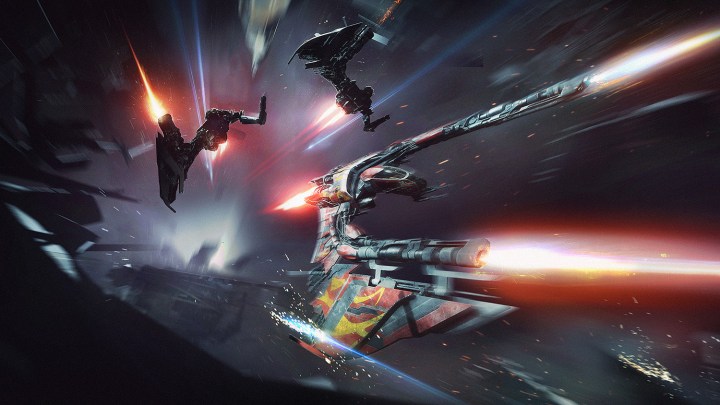
For Star Citizen creator, Cloud Imperium, it was down to a combination of Amazon’s Web Services (AWS), the engine’s royalty free model, and the fact that it was built on the same CryEngine code base as the game.
Star Citizen is one of the most attractive and most expansive games currently under development so the fact it has adopted Lumberyard is quite an endorsement. Both the game and the engine are ambitious projects, but moving over to a new engine half-way through development is often no mean feat, and Lumberyard itself has yet to prove its worth in a manner equivalent to its contemporaries.
To find out what Lumberyard’s features can add to the Star Citizen formula, and how the transition has gone, we organized a digital sit-down with Cloud Imperium COO, Carl Jones.
Digital Trends: How much of a transition process was involved in moving from the original engine to Lumberyard?
Carl Jones: We found it very easy to transition as our engine and Lumberyard share a similar base in CryEngine. We made extensive changes in our engine from the ‘vanilla’ CryEngine, as had Amazon with Lumberyard, so for us the approach was to strip each engine down to their matching parts – then add our changes back again to the common core. Essentially this was the work of only a few days, so it was a very easy transition indeed.

You originally stated that Star Citizen’s development would not be delayed by adopting Lumberyard. Is that still the case now that you’ve been working with it for several months?
Yes – the change to Lumberyard hasn’t delayed us on the project. In fact, in some cases, such as utilizing the new graphics features implemented in Lumberyard, it saved time and sped things up compared to the very drawn out process of creating that work from scratch.
How much of an overlap was there between Lumberyard and the changes you had already made to the version of CryEngine you were working with?
Not so much. We’re lucky to have the engineering resources and talent to completely customize and rebuild huge amounts of our engine, as any ambitious project would, and we’ve done that to specifically service our games’ needs. Amazon has quite rightly built Lumberyard to service many different games and game developers.
“We will be able to do a lot more for Star Citizen and Squadron 42 without being concerned about the cost”
Both engines have advanced well beyond the original CryEngine base, but they have moved in different directions and will continue to do so. While this means we can’t benefit automatically from all the changes Amazon makes to Lumberyard by simply merging code, that’s really not a problem for us. Amazon has sensibly architected Lumberyard to be as modular as possible, which means we don’t have to make any wholesale changes to our technology, yet we can look at improvements Amazon makes on a case by case basis, and take advantage of them if we feel it works with our games.
We were already in a position where we were only ‘cherry picking’ changes to CryEngine, so not much changed for us there, and Amazon is making Lumberyard in such a way that this can continue indefinitely.
Since you adopted CryEngine 3 before the free-license change, did the move to Lumberyard and its royalty free model, mean it was a cost saving for Cloud Imperium?
Well you can’t get better value than free, of course! In the future, it means we will be able to do a lot more for Star Citizen and Squadron 42 without being concerned about the cost of licensing technology, which is no bad thing, but it doesn’t make a huge difference for us economically, in the short term.
Was the decision to move to Lumberyard at all based on the financial difficulties faced by Crytek?
We certainly wanted a technology partner that could support us and be with us for the long term, investing in tools and technology year after year, which Amazon of course can uniquely deliver. But mostly we liked Amazon’s strategy for gaming, specifically with Lumberyard, Twitch and AWS. We knew that over time Amazon would create the best game engine and support technologies to enable and power online games using AWS – it’s inevitable and will be a big help to us and our community, now and in the future. We’re always looking long term at CIG, and with Amazon as a partner, we’re able to feel confident about the future.

In what way will Star Citizen leverage the Amazon Web Services integration with Lumberyard?
We have built our game since day one to take advantage of cloud computing and have always run our platform and game environments on cloud platforms. We’re live on AWS now and taking advantage of AWS features in many ways. I can’t go into technical details at this point, but there are technologies we are working on now on AWS that will enable us to have the most detailed, massively populated universe for our players to explore and interact with. Some of these things simply have never been done before and we’re finding more ways to benefit from the architecture of AWS all the time.
Will Star Citizen make use of any or all the streamer-focused features like Twitch ChatPlay?
We have some really cool ideas for supporting Twitch and live streaming in Star Citizen, which we expect to be able to start showing around Gamescom time. We also have our own social platform, Spectrum, which we are looking to tie into Twitch and streamers in interesting ways in the future.
As one of the earliest big names to publicly adopt Lumberyard, has Cloud Imperium helped guide any other studios in their uptake of the engine?
“We knew that over time Amazon would create the best game engine”
I’ve personally recommended the engine, based on our positive experience with it and the support provided by Amazon, but game developers will always choose the right engine for their project, as no single engine can excel in every situation.
Are you working with Amazon and the Lumberyard team to provide feedback and ideas for its ongoing development?
We are in contact with the guys over there and we do talk a lot about our respective plans and roadmaps – but we don’t look to guide the future of Lumberyard for our benefit, per se. We agree that Lumberyard, like any engine, should be built to benefit all developers, but probably with more attention given to smaller, independent developers who need a simple, easy to use engine to create their content. Lumberyard can reduce the barrier to entry for upcoming game developers to create high quality content quickly. While we benefit indirectly from that, we’re happy to see the industry benefit from another game engine in the mix.
If Cloud Imperium were to finish Star Citizen tomorrow and begin work on a new project, would you pick Lumberyard as the basis for it again?
You have to pick the right engine for the game, but I think in most cases, I would say yes we would choose Lumberyard. It is really great for high-end PC game development, which is what we want to do. Of course, we have built a lot of our own technologies and tools with Lumberyard now, so our investment there would benefit us in making more games for our community using this engine.

Conclusion
While Star Citizen as a project has been mired by delays, and even five years on from its original unveiling is still considered exceedingly ambitious, Cloud Imperium does appear confident that Lumberyard can help bring it to completion. More importantly, Lumberyard’s flagship feature, its Amazon Web Services integration, has become a key component of Star Citizen‘s back-end structure.
It may well be that the AWS and streamer features will help drive much of the adoption of Lumberyard moving forward, though its royalty free model will certainly be attractive to developers big and small. That said, while Lumberyard’s success does not hinge on Star Citizen‘s, it would certainly benefit from it. With only a handful of games officially under development with Lumberyard, the first big one to see release will set the tone for the engine’s reception.
Time will tell whether this marriage of ambition between Cloud Imperium and Amazon pays off, but Carl Jones certainly seems confident that it’ll work.




